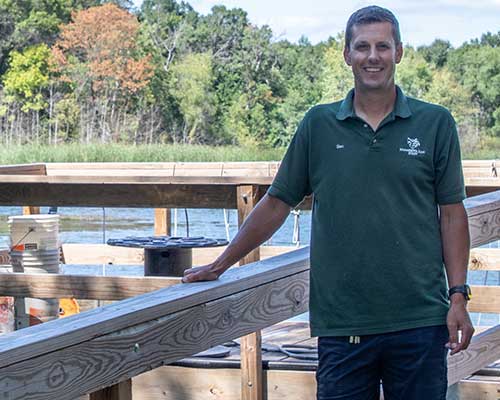Ben Minerich
Did you know that there are about 300 species of fresh water mussels in North America? Master of Biological Sciences student Ben Minerich does. And he also knows that roughly 70% of them are imperiled. As a mussel conservation specialist at the Minnesota Zoo, Minerich’s research centers on bringing these bivalves back from the edge of extinction.
Headwaters
Minerich has traveled the country working in aquariums and zoos, studying in Oregon, Florida, and Wisconsin, from SeaLife Aquarium to Disney's The Seas. He was even on track to become a biology teacher for a while, until the call of the field (or, rather, stream) became too strong to ignore.
Minerich wanted to dig deeper into rigorous scientific research. He was also eager to learn how to better communicate his ideas and findings and have the skills to enlarge a research program on his own. The MBS program allowed him to pick the courses that would round out his knowledge and position him for a larger research role.
“The MBS program offered me the flexibility to keep working full time. It fit into my schedule well. I asked my wife, my boss, and my two kids, and they all said ‘we’re in’.”
“I was more than just grades on paper: they looked at my experience and progress to give me a second chance at pursuing higher education.”
“Applying to the program was an easy experience," he says. "My undergraduate grades didn’t reflect the education, training, and passion I discovered in this field after college. I’m grateful for the support I got from Brad Fruen, my advisor. I was more than just grades on paper: they looked at my experience and progress to give me a second chance at pursuing higher education.”
Three courses that stand out for him so far are Limnology, Hydrology, and Aquatic Insects and Pollution. The courses gave him the tools and the vocabulary to expand his thought process to a more geologic scale, to take a multifactored approach.
“I’ve had experience with a lot of different water-quality sensing equipment in my career. I was familiar with the tools and techniques, but I learned how to apply meaning to their data in a more complex way, to not only see how a system functions, but anticipate what changes are ahead in a dynamically changing ecosystem. It was a huge step up for me,” he says. “It’s like reading a book for the second time.”
A Species Puzzle
Right now, Minerich’s time is spent in the Zoo’s new mussel research facility, which, in partnership with the Minnesota Department of Natural Resources and the US Fish and Wildlife Service, raises young native mussels for release into the wild once they are large enough.
“My career has so far been focused on the care of aquatic animals,” he says. “This was a great opportunity to get more involved in research. I’m excited to apply what I’ve learned propagating corals and jellyfish to my experience with mussels in a scientific way, to see how their husbandry needs can be quantified in a similar manner.”
“People who study mussels love everything about studying mussels."
Minerich is exploring how to best propagate and restart mussel populations, which involves finding ideal habitats and growing conditions for different types of species.
“Juveniles for each mussel species might just look like the same little rocks spread throughout a stream bed, but each one may prefer different microhabitats than where other species or adults are found. We need diversity in streams to fulfill the different species’ needs, which translates to mussels performing filtering services in all stretches of a water body. So with these propagation efforts, it’s important to grow the right species under the right conditions.”
Mussels are important for filtering water (reducing sediment and algae levels in the water column) and building habitats for fish and aquatic insects. Their numbers have been decreasing due to over-farming, dam building, pollution, invasive species, and decrease of fish populations, which mussels need for reproduction.
“I like that there is always something new to learn,” Minerich says, “that there are always new details to figure out. There is still work to be done, something to work toward.”
He adds, “People who study mussels love everything about studying mussels. You see their eyes light up at the opportunity to share even a little bit about these often overlooked animals.”











